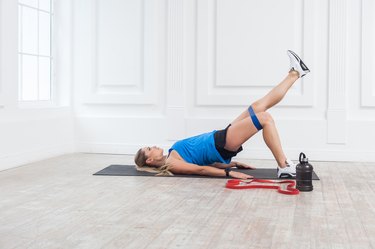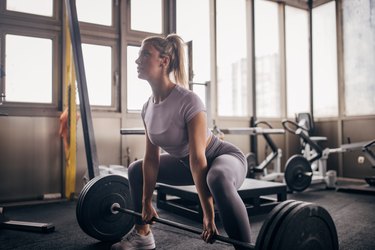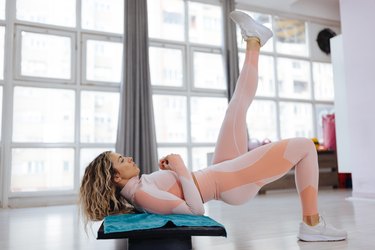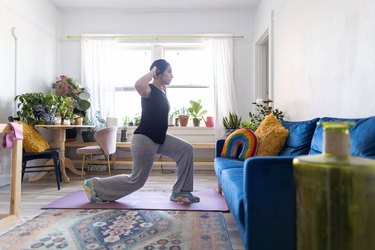
It's easy to tell when certain muscles, like the ones in your arms, are weak: You can't pick up a heavy box in the attic or hoist your suitcase into the overhead compartment on a plane. But it's a little less clear how to tell when your glutes are weak. The signs are there; you just have to know what to look for.
And though your glutes (technically three muscles: the gluteus maximus, medius and minimus) make up your butt, the signs of weakness don't have much to do with a less-than-perky backside. Instead, you might actually have pain in certain areas.
Video of the Day
Here, Holly Perkins, CSCS, founder of Women's Strength Nation and creator of The GLUTES Project ACTIVATE, shares three ways you can tell your glutes are weak, plus what you can do about it.
Join the LIVESTRONG.com 4-Week Butt Lift Challenge.
1. Your Lower Back Arches — a Lot
Find a full-length mirror, stand sideways with your natural posture (no posing!) and take a look at your booty and back.
A pronounced lower-back arch "most often points to weak glutes not holding your pelvis in a neutral position," Perkins says. Your hips should be level, but if your glutes aren't strong enough, your hip bones will tilt forward and cause your lower back to arch. "While you should have a curvature in your lower back, it is important to not be exaggerated."
Since a big arch in your lower back may also be a sign of a weak core, it's important to pay attention to the two other signs below, as well. Or play it safe and make sure your workouts target both your core and your glutes.
2. You Have Lower-Back, Hip and/or Knee Pain
Another surefire way to tell that your glutes aren't, well, firing is that you have chronic lower-back, hip or knee pain, Perkins says. "While there could be several causes (barring an acute injury), most often this is a sign that your glutes are weak."
That's because nothing in your body works completely independently of the other parts. Think of your lower body as an interconnected chain.
"Your glutes are the powerful foundation to hold your pelvis in an optimal position," Perkins says. "When your glutes are weak, your pelvis rotates forward, causing misalignments throughout your body and creating improper angles of the pelvis and knees."
Your body wasn't designed to function with your hips tilted forward. When they are, the other muscles in that chain can't contract and relax the way they're supposed to. They're working hard to compensate for the weak link, but that means they're either moving in a weird way or being overused — both of which can result in aches and pains.
3. You Sit Too Much
This may seem like a no-brainer, but it's worth pointing out: If you sit for more than four hours per day (so, probably most of us) and don't include glute-focused exercises in your workouts every week, your glutes are probably weak.
"The truth is, the glutes become weakened very easily by sitting because it turns off the neuromuscular conversation from your brain," Perkins says. Basically, you're brain isn't telling your glutes to fire (like it would be if you were standing or walking) because you don't need to use those muscles when you're sitting on them.
As you've probably heard before, that means you should get up out of your seat and take a walking or stretch break every 30 minutes — even if it's just to go to the bathroom, refill your water bottle (double health points!), grab a snack or join a meeting.
What Can You Do About Weak Glutes?
Strengthen them, of course! But that can be especially tough if you're dealing with the aches and pains outlined above. Plus, while squats and lunges are great lower-body exercises, they're not your best bet for targeting the glutes.
"The best way to keep your glute muscles firing is to spend a few minutes every day doing these activation exercises [see example below], as well as two to three dedicated workouts a week that include specific exercises to strengthen your glutes," Perkins says.
Activate: Hip Thrust
- Sit on the floor with your shoulder blades pressed into a bench (even a sturdy couch or chair will do).
- Place your feet shoulder-width apart and turn your toes out slightly.
- Brace your core, drive into your heels and press your hips up. Rotate your pelvis under (called a posterior tilt) and squeeze your glutes, ending with your hips locked in a fully opened position. Your knees should be at a 90-degree angle.
- Press your knees outward, then pause at the top for a few seconds before lowering back down to the starting position.
Reps: 15 to 20
Strengthen: Glute Kickbacks
- Start on all fours with your wrists below your shoulders and your knees below your hips. You can also do this exercise standing as demonstrated above.
- Keeping your hips square to the ground and your knees bent at a 90-degree angle, lift your right foot toward the sky as though you are stamping the bottom of your shoe on the ceiling. Squeeze through your glutes to lift.
- Lower that leg back down, but before you let it rest on the floor, lift your right knee out to the side, keeping your knee bent at a 90-degree angle.
- Lower back down and go back to the glute kickback.
- Switch to the left side after reaching fatigue on the right side.
Reps: 15 to 20 on each side


